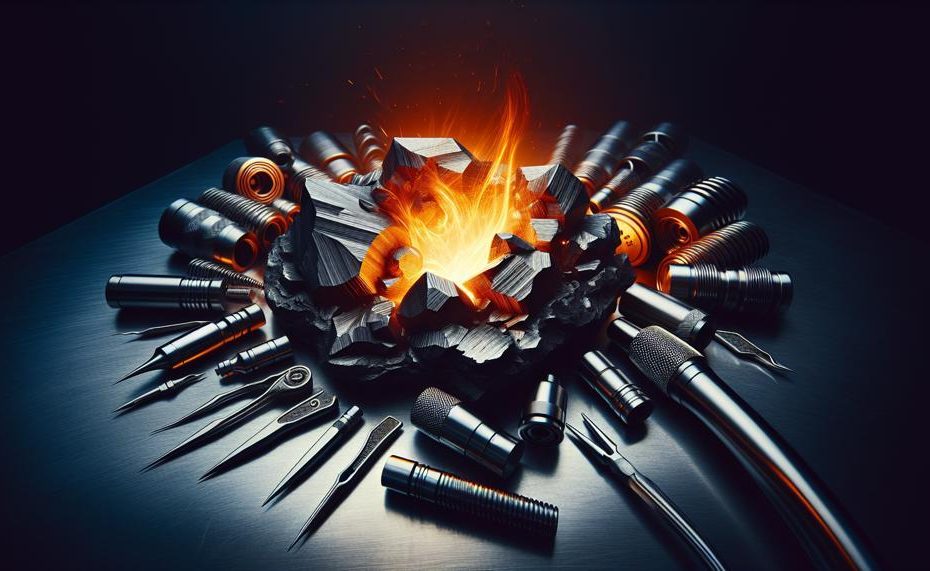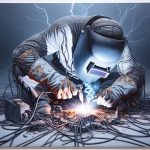Are you looking for stainless steel products that are both strong and durable? It’s the ultimate alloying element for enhancing the properties of stainless steel. A plethora of tungsten options are available. It can be overwhelming to determine which one is best suited for your needs.
We’re here to break it down for you with a quick bullet point list:
- Tungsten carbide: Known for its extreme hardness and wear resistance, this type of tungsten is perfect for cutting tools and wear-resistant coatings.
- Tungsten heavy alloys: With a high percentage of tungsten, these alloys are ideal for applications where density and weight are crucial, such as in aerospace and defense industries.
- Pure tungsten: As its name suggests, this type of tungsten is 100% pure and boasts excellent high-temperature strength and corrosion resistance, making it suitable for furnace components and electrical contacts.
But when it comes to stainless steel, one type of tungsten surpasses all others – tungsten-molybdenum. This alloy offers a perfect balance of strength, toughness, and corrosion resistance. It’s the top choice for manufacturing high-quality stainless steel products.
So, let’s start.
Contents
RED Thoriated Tungsten
RED Thoriated Tungsten is a type of tungsten electrode. It is frequently used in Tungsten Inert Gas (TIG) welding. It is made up of 2% thorium oxide, a radioactive element. Thorium oxide imparts the electrode with exceptional conductivity and high-temperature resistance.
The distinctive red color on the tip of the electrode helps identify its composition. It also distinguishes it from other types of tungsten electrodes.
Additionally, RED Thoriated Tungsten maintains a sharp point throughout the welding process. This is crucial for precise and concentrated heat application on stainless steel. This helps prevent overheating and distortion of the metal. It results in superior quality welds.
RED Thoriated Tungsten has an extended lifespan compared to other tungsten electrodes. This makes it a cost-effective option in the long run.
It can retain its shape and sharpness for a long time. This means you need to replace it less often. In the end, this lowers overall welding costs.
Blue Lanthanated Tungsten for Stainless Steel
Blue lanthanated tungsten is widely considered to be the top choice for welding stainless steel. This is due to its exceptional properties. These properties include a high melting point, strong arc stability, excellent electrical conductivity, low consumption rate, and user-friendly nature.
It is no surprise that blue lanthanated tungsten has become the go-to tungsten electrode for welding stainless steel. Industries such as automotive, aerospace, and construction use it.
This type of tungsten allows welders to easily produce high-quality, precise welds on stainless steel.
Gold Lanthanated 1.5% Color Tungsten
Gold Lanthanated 1.5% Color Tungsten is a special type of tungsten electrode. It has a gold-colored stripe at its end and contains 1.5% lanthanum. This unique electrode offers numerous benefits when working with stainless steel, including:
- Superior arc initiation: With its excellent arc initiation capabilities, Gold Lanthanated 1.5% Color Tungsten makes it effortless to start and maintain an arc throughout the welding process. This makes it the go-to choice for precision welding on stainless steel.
- Low rate of burnoff: Thanks to its low rate of burnoff, the Gold Lanthanated 1.5% Color Tungsten electrode has a longer lifespan, minimizing the need for frequent electrode replacements during welding.
- Stable arc performance: The arc produced by this type of tungsten electrode is highly stable, ensuring consistent and controlled welds on stainless steel.
- Versatility: Gold Lanthanated 1.5% Color Tungsten can be used for both AC and DC welding, making it suitable for a wide range of welding applications on stainless steel.
- Increased maximum current capacity: The addition of 1.5% lanthana in these electrodes boosts their maximum current-carrying capacity by approximately 50%, allowing for higher current levels without compromising weld quality.
- Retains sharp point: One major advantage of Gold Lanthanated 1.5% Color Tungsten is its ability to maintain a sharp point, making it ideal for welding stainless steel on both DC and AC from square wave power sources.
Gold Lanthanated 1.5% For Tig Welding Stainless Steel
Using Gold Lanthanated 1.5% tungsten in TIG welding stainless steel has many advantages. These include enhanced stability and lifespan, improved arc performance, and increased safety measures. Let’s delve deeper into these benefits.
- Exceptional stability and extended lifespan: The addition of lanthanum oxide in Gold Lanthanated 1.5% tungsten results in exceptional stability and prolonged electrode life. This is attributed to the lower burnoff rate of lanthanum, which enables the electrode to maintain its shape and sharp point for extended periods.
- Improved arc performance: With a 1.5% lanthanum inclusion, this type of tungsten boasts a significant increase in maximum current-carrying capacity, providing approximately 50% more capacity than other tungsten types. This allows for better control and precision when welding stainless steel.
- Enhanced safety: Gold Lanthanated 1.5% tungsten has zero radioactive hazard levels, making it a safer option compared to other tungsten alternatives like thoriated tungsten. This also eliminates any disposal restrictions for this type of tungsten.
- Versatility: Gold Lanthanated 1.5% tungsten can effectively replace multiple types of tungsten in most welding applications, making it a cost-effective choice for TIG welding stainless steel.
- Ideal for heavy wall stainless steel: The low burnoff rate and exceptional reignition characteristics of Gold Lanthanated 1.5% tungsten make it ideal for heavy wall stainless steel welding, where frequent electrode replacements can be expensive and time-consuming.
Grey Ceriated Tungsten For Welding Stainless Steel
When welding stainless steel, using grey ceriated tungsten electrodes has several advantages over other types. It has a high resistance to arc wandering. It also has a low burn-off rate and a higher current-carrying capacity.
Additionally, it has a low tendency to form a ball at the end. This makes it easier to control and produces precise welds. Its low melting point and corrosion resistance make it an ideal choice for welding stainless steel materials.
Moreover, grey ceriated tungsten is known for its cost-effectiveness. Compared to other tungsten electrodes, it has a longer lifespan. This makes it more economical in the long run. This makes it a popular choice among welders. They are looking for quality and cost savings.
Welders can achieve better weld quality, increase productivity, and save on costs by using grey ceriated tungsten.
Purple Tungsten For Stainless Steel
Purple tungsten (E3 electrode) is a non-radioactive alternative to traditional thoriated tungsten electrodes. It boasts exceptional performance and extended durability. This is thanks to its lower operating temperature when using the same current density.
This makes it the top choice for welding stainless steel. It provides a safer option without sacrificing welding quality.

| Color | Chemical Composition | Benefits for Welding Stainless Steel |
| Purple (E3) | Non-radioactive | Exceptional performance, extended durability due to lower operating temperature |
| Grey Ceriated | Cerium oxide (2%)* | High resistance to arc wandering, low burn-off rate, high current-carrying capacity, precise welds, cost-effective |
| Lanthanated | Lanthanum oxide (1.5%)* | Effortless arc starts, sharp points, increased current-carrying capacity without radioactive hazards* |
| Thoriated (blue, purple, red) | Thorium oxide (2%)* | High-amperage capability, ability to handle heavy wall stainless steel* |
| Gold | Mixed with rare-earth oxides* | Poor performance on AC, quick loss of fine point* |
Conclusion
In conclusion, when finding the perfect strength and durability in stainless steel, tungsten is the ultimate alloying element. Various tungsten options are available. It can be overwhelming to determine which is best for your needs. But fear not, we’ve got you covered with a quick bullet point list.
When it comes to stainless steel, there’s one type of tungsten that surpasses all others: tungsten-molybdenum. This alloy offers a perfect balance of strength, toughness, and corrosion resistance. It is the top choice for manufacturing high-quality stainless steel products.
But don’t just take our word for it. Professionals in various industries have firsthand experience with the remarkable benefits of using different types of tungsten electrodes. They include RED Thoriated Tungsten, Blue Lanthanated Tungsten, Gold Lanthanated 1.5% Color Tungsten, Grey Ceriated Tungsten, and Purple Tungsten (E3 electrode). These electrodes are useful when welding stainless steel.
- RED Thoriated Tungsten offers exceptional conductivity and high-temperature resistance for precise welding on stainless steel.
- Blue Lanthanated Tungsten boasts a high melting point and stability for improved control and precision when welding stainless steel.
- Gold Lanthanated 1.5% Color Tungsten provides superior arc initiation and stability while being versatile and safe to use on stainless steel.
- Grey Ceriated Tungsten stands out for its high resistance to arc wandering, low burn-off rate, and cost-effectiveness when welding stainless steel.
- Purple Tungsten (E3 electrode) offers exceptional performance and extended durability at a lower operating temperature for safe and high-quality welds on stainless steel.





